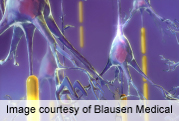
MONDAY, July 16 (HealthDay News) — Aiming for insights into Alzheimer’s disease, scientists have developed a new cellular model for research — one that’s sourced from the skin cells of patients but genetically reprogrammed to mimic diseased brain cells.
The scientists say their approach might draw on the stem cells of people with Alzheimer’s disease as a virtually limitless supply of different types of diseased brain cells for laboratory study.
The results were to be presented Monday at the Alzheimer’s Association annual meeting in Vancouver.
Theoretically, the innovation could improve upon the current method of study, which primarily relies on mouse-based models. Researchers say that such animal research, while often fruitful, falls short of fully representing the disease environment found in human patients.
“Current animal models of Alzheimer’s are highly engineered to express elements of the disease and, while valuable for research, incompletely represent how the disease forms and progresses in people,” William Thies, chief medical and scientific officer for the Alzheimer’s Association, said in a news release from the meeting’s organizers.
“In order to develop better therapies and eventually prevent Alzheimer’s, we need better, more accurate animal and cellular models of the disease,” Thies added. “This newly reported research is a significant step forward in that direction.”
The study was led by Andrew Sproul, a postdoctoral associate at the New York Stem Cell Foundation in New York City. Sproul and his colleagues noted that the telltale amyloid protein plaques that build up in the brains of human Alzheimer’s patients also differ from those found in mice.
With that in mind, the authors worked with cells from 12 Alzheimer’s patients along with several healthy family members. All the patients had been diagnosed with the most common form of a rare type of an early-onset form of Alzheimer’s disease (representing just 2 percent of all cases) that is known to be inherited.
After extracting skin cells from the study participants, the team used genetic engineering to prod the cells into developing into several kinds of “electrically active” brain cells — forebrain nerve cells, neural stem cells and glial cells.
The team noted that because most Alzheimer’s patients suffer from a different, late-onset type of disease, more work will have to be done to broaden this new approach so that it covers that form of the disease.
“Over the next few years, we expect to provide substantial insight into Alzheimer’s and valuable tools to help create the next generation of therapeutics,” Sproul noted.
Research presented at medical meetings is typically considered preliminary until published in a peer-reviewed journal.
More information
For more on Alzheimer’s disease, visit the U.S. National Institute on Aging.

